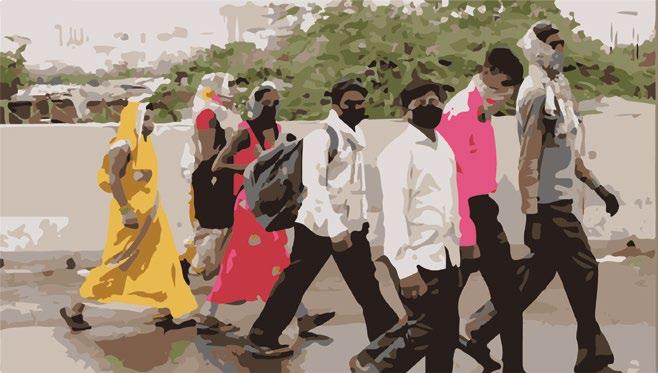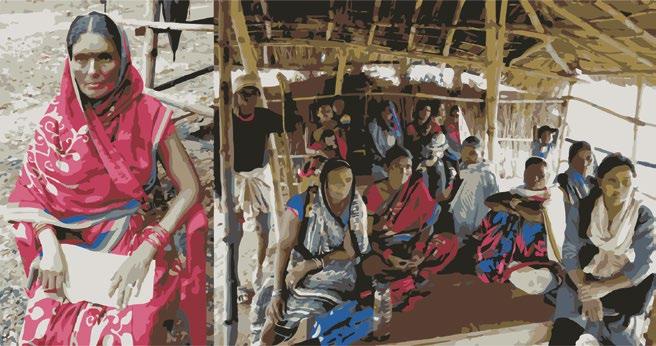
6 minute read
GENDER
Image source: Discover Society
Violence against women in India
Three months into the year 2020, a nationwide lockdown in wake of the COVID-19 pandemic forced both, men and women, to stay indoors. This was across all social and economic strata. The lockdown also meant a lot of people lost their jobs due to businesses cutting costs to get through the lockdown. This meant increasing stress and frustration which sometimes manifests itself into violence.
Gender-based violence is defined by the United Nations as any act of violence that results in physical, sexual, or psychological harm or suffering to women, girls, men, and boys, as well as threats of such acts, coercion, or the arbitrary deprivation of liberty.2
To speak about violence against women is to understand that violence is not just physical and does not just include battery or assault. Violence can manifest itself into physical, emotional, verbal, sexual, and economic violence. Emotional violence is difficult to understand even for women themselves. It could include humiliating in front of people, threatening to hurt or harm the woman or someone close to her, insulting or making her feel bad about herself.
A study conducted by National Family Health Survey (NFHS) in 2015-16 found that 52% of women and 42% of men believe that a husband is justified in beating his wife in at least one of seven specified circumstances. The study observed that this trend had not seen much change since it last study of 200506.3 The NFHS study further found that 30% of women have experienced physical violence since age 15, and 6% have ever experienced sexual violence in their lifetime; 4% of ever-pregnant women have experienced physical violence during any pregnancy. Only 14% of women who have experienced physical or sexual violence by anyone have sought help to stop the violence; this percentage was 24% in the study of 2005-06.
As Dr. Indu Agnihotri points out in an article in The Wire,4 violence against women is a critical manifestation of social crisis and conflict that have roots in structures upholding inequalities, social hierarchies and policies of discrimination and exclusion. The exclusion of women from access to resources, policy making and justice is the violence that needs to be recognized.
Legislative background
Domestic violence was included under the definition of offence of ‘cruelty’ under section 498A of the Indian Penal Code (IPC) since 1983. It was only in 2006, that domestic violence was addressed as a real problem and a law was formulated to redress the same. The Protection of Women from Domestic Violence Act 2005, which came into effect in 2006, granted civil protection to women against domestic violence, while providing a comprehensive definition of domestic violence including all forms of physical, emotional, verbal, sexual, and economic violence while also including threats of such violence. The Act requires the appointment of protection officers to assist victims, and further acknowledges the importance of collaboration between the government and external organizations in protecting women. The fight against sexual violence bolstered after the 2012 Delhi gang rape case which brought in the report of the Justice Verma Committee which drastically changed the penal code to becoming more favourable for redressal of crimes against women and classified them better. Crimes such as throwing acid, sexual harassment, assault with intent to disrobe, voyeurism, stalking found place in the IPC thus enabling women to register these crimes. The definition of rape was also drastically changed to include all kinds of heinous acts that amount to rape.5
There are, however, still some lacunae in penal law that do no address crimes against women. For example, there is no law that punishes a public servant for resorting to any kind of sexual violence or even assault by a male officer on a woman.
Judicial intervention
The intervention of the judiciary is important in jurisprudence but it is more pertinent and important that this intervention culminates into a proper conclusion: justice to the victim. One needs to also look at the pendency of cases and rate of conviction in cases of crimes against women. NCRB data of 2018 states that the conviction rate in rape cases was a mere 27.2%.6
The failure of the criminal justice system is reflected in incidents such as a rape survivor setting herself ablaze after the rape accused was granted bail,7 and in another incident in Unnao itself the accused set the rape survivor ablaze as she was son her way to the hearing.8 Cleary, courts had a role to play here and substantively failed and continue to fail to protect survivors in such heinous attacks.
Current scenario
The National Commission for Women (NCW) received 2,914 complaints of crimes against women, 660 of which were pertaining to domestic violence. 9 Among all kinds of violence, National
Crime Records Bureau (NCRB) data of 2018 shows that domestic violence against women was the highest reported gendered crime that year. A total of 89,097 cases related to crimes against women was registered which was a marginal rise from the 86,001 cases in Gendered violence persists not just in domestic spaces, but also take place in public places, secure environments such as educational institutes, and many a times even inflicted by public servants. The past few months have been testimony to this as police excess was experienced across the country especially in Delhi and Uttar Pradesh and the police personnel resorted to sexual violence and torture on women part of protests against the Citizenship Amendment Act (CAA). A report by National Federation of Indian Women released a fact-finding report which stated that women as well as men were assaulted on their sensitive areas as they were disbursing a march of Gendered custodial violence were witnessed in a wave of attacks on Adivasis in Uttarakhand12 as well as Dudhwa National park13 in Uttar Pradesh. While no FIR was allowed to be registered in the Uttarakhand incident, an FIR has been lodged for the UP incident.
the previous year.10
The way forward protesters.11
Since restriction of movement is still in place in some regions and unemployment is at its peak, it means the threat of domestic violence persists. Complaints of violence received must be redressed immediately by providing access to women to shelters or facilitate removal of the abuser from the household As courts are functioning in a restricted manner, courts should give importance to hearing cases of crimes against women and grant interim reliefs to womenAs courts are functioning in a restricted manner, courts should give importance to hearing cases of crimes against women and grant interim reliefs to women As courts are functioning in a restricted manner, courts should give importance to hearing cases of crimes against women and grant interim reliefs to women Ensure help lines, one stop centres, women police stations etc. are available at all times There is further need to enhance the gender sensitivity of the police, who need to work closely with women’s groups to formulate safety plans of action for women.
1) https://indianexpress.com/article/opinion/columns/delhi-gangrape-nirbhayacasewomen-safety-unsafe-at-home-and-in-the-workplace-4990390/ 2) https://dhsprogram.com/pubs/pdf/FR339/FR339.pdf 3) https://dhsprogram.com/pubs/pdf/FR339/FR339.pdf 4) https://www.iitk.ac.in/wc/data/TheCriminalLaw.pdf 5) https://ncrb.gov.in/sites/default/files/Crime%20in%20India%202018%20-%20 Volume%201.pdf 6) https://indianexpress.com/article/india/another-unnao-rape-victim-sets-selfafire-afteraccused-gets-bail-6170628/ 7) https://www.thehindu.com/news/national/other-states/unnao-rapevictim/ article30236853.ece 8 https://www.newindianexpress.com/nation/2020/aug/09/national-commissionforwomen-received-2914-complaints-in-july-highest-since-2018-2181164.html 9) https://www.nationalheraldindia.com/national/domestic-violence-tops-crimeagainstwomen-in-2018-ncrb 10) https://nfiw.wordpress.com/ 11) https://sabrangindia.in/article/van-gujjars-assaulted-police-and-forest-officialscjpmoves-nhrc-demanding-justice 12) https://sabrangindia.in/article/assault-tharu-women-prompts-fir-forestofficials-flexmuscles
RIGHTS VIOLATIONS











